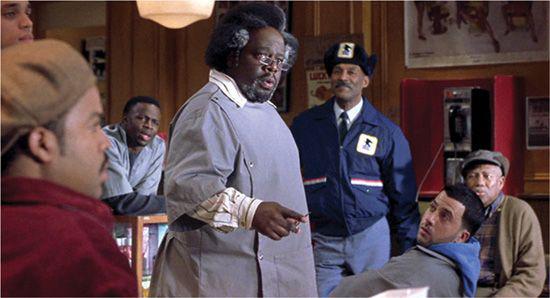B0041VYHGW EBOK (136 page)
Authors: David Bordwell,Kristin Thompson

Most cinema genres and subgenres become established when one film achieves success and is widely imitated. After several films that resemble one another appear, people begin to compare them. For example, in the late 1990s, the term
gross-out
came to be commonly applied to a group of films, including
Ace Ventura, Pet Detective; There’s Something About Mary;
and
American Pie.
But critics then traced this “new” subgenre back to such influential comedies as
Animal House
(1978) and
Porky’s
(1981).
Similarly, when the television-related fantasy
Pleasantville
appeared in 1998, some critics linked it to comparable films:
Big
(1988),
Splash
(1984),
Peggy Sue Got Married
(1986),
Groundhog Day
(1993),
The Truman Show
(1998), and
Sliding Doors
(1998). Reviewer Richard Corliss suggested a new term for the subgenre,
fantasies of displacement.
Lisa Schwartzbaum called such films
magical comedies.
Whether these or other phrases ever become common parlance, many viewers might recognize that these films share traits that set them apart. Such comments by reviewers are one way in which new subgenres come to be recognized.
Once a genre is launched, there seems to be no fixed pattern of development. We might expect that the earliest films in the genre are the purest, with genre mixing coming at a late stage. But genre mixing can take place very soon.
Whoopee!
(1930), a musical from the beginning of talking pictures, is also a Western.
Just Imagine
(1930), one of the first sound science-fiction films, contains a comic song. Some historians have also speculated that a genre inevitably passes from a phase of maturity to one of parody, when it begins to mock its own conventions. Yet an early Western,
The Great K & A Train Robbery
(1926), is an all-out parody of its own genre. Early slapstick comedies often take moviemaking as their subject and ruthlessly poke fun at themselves, as in Charlie Chaplin’s farcical
His New Job
(1915).
Typically, genres do not remain constantly successful. Rather, they rise and fall in popularity. The result is the phenomenon known as
cycles.
A cycle is a batch of genre films that enjoy intense popularity and influence over a distinct period. Cycles can occur when a successful film produces a burst of imitations.
The Godfather
triggered a brief spate of gangster movies. During the 1970s, there was a cycle of disaster movies (
Earthquake, The Poseidon Adventure
). There have been cycles of comedies centering on spaced-out teenagers (
Wayne’s World, Bill and Ted’s Excellent Adventure, Dude, Where’s My Car?
), buddy-cop movies (
Lethal Weapon
and its successors), movies adapted from comic books (
Batman Begins, Spider-Man, Hellboy
), romantic thrillers aimed at a female audience (
Dead Again, Double Jeopardy
), and dramas describing coming of age in African-American neighborhoods (
Boyz N the Hood, Menace II Society
). Few observers would have predicted that science-fiction movies would return in the 1970s, but
Star Wars
created a long-lasting cycle. A cycle of fantasy adventures including the
Lord of the Rings
trilogy, the
Harry Potter
series, and the
Chronicles of Narnia
franchise, emerged in the early 2000s.
It seems likely that a genre never dies. It may pass out of fashion for a time, only to return in updated garb. The sword-and-sandal epic set in ancient times was popular in the 1950s and 1960s, then virtually disappeared until Ridley Scott revived it to considerable acclaim in 2000 with
Gladiator
—inspiring other filmmakers to undertake
Troy, Alexander,
and
300.
A genre may also change by mixing its conventions with those of another genre. In 1979,
Alien
proved innovative because it blended science-fiction conventions with those of the contemporary horror film, centering on a monster stalking its victims one by one. The rusting spaceship became the futuristic equivalent of the old dark house full of unseen dangers. By the early 2000s, the science-fiction/horror blend was itself quite conventional, as in
Pitch Black
and
Doom.
The musical and the comedy blend easily with other genres. During the 1930s and 1940s, singing cowboys such as Gene Autry were popular, and the Western musical was revived in the 1960s with
Cat Ballou.
There have been musical melodramas, such as
Yentl
and two versions of
A Star Is Born. The Rocky Horror Picture Show
created the musical horror movie.
Comedy as well can blend with any other genre. The dramatic issue at the core of
Barbershop
—whether a son should sustain his father’s business for the good of the community—is lightened by sight gags, inventive insults, and scabrous monologues
(
9.6
).
Mel Brooks and Woody Allen have created comedies out of the conventions of science fiction (
Spaceballs, Sleeper
), Westerns (
Blazing Saddles
), outlaw films (
Take the Money and Run
), thrillers and detective stories (
High Anxiety, Manhattan Murder Mystery
), even historical epics (
History of the World
Part I
,
Love and Death
). The combinations seem almost limitless. In
O Brother, Where Art Thou?
bumbling prison escapees accidentally become country singing stars, and the result is at once an outlaw movie, a social protest film, a slapstick comedy, and a musical.

9.6
Barbershop:
Eddie’s rants offer a comically skeptical attitude toward Rosa Parks and other African-American icons.
“So it’s kind of a psychic political thriller comedy with a heart.”
“With a heart. And not unlike
Ghost
meets
Manchurian Candidate.
”— Producer and screenwriter in the opening scene of Robert Altman’s
The Player
In some cases, genres influence and mix with one another across cultures. The Japanese swordplay genre, with its conventions of swordplay and revenge, has blended well with a parallel genre, the Western. Sergio Leone based his Italian Western
For a Fistful of Dollars
loosely on the plot of Akira Kurosawa’s
Yojimbo,
and the same Japanese director’s
Seven Samurai
provided the basis for the Hollywood Western
The Magnificent Seven.
Similarly, widespread fan interest in Hong Kong movies during the 1980s and 1990s led the Wachowski brothers to mix high-tech science-fiction effects with Hong Kong martial-arts choreography in
The Matrix.
Such mixtures are often consciously recognized by filmmakers and audiences alike. Filmmakers may take elements of two or more successful films, blend them, and spin off an entirely new concept. Similarly, spectators are used to comparing new films with existing ones. If someone who has not seen
Pleasantville
asks a friend what it is like, the reply might be “It’s sort of a combination of
The Truman Show
and
Back to the Future.
” That is, it’s a fantasy film dealing with television, but it also has a science-fiction element of a time machine.
The fact that genres can intermingle does not, however, mean that there are no distinctions among them.
The Matrix
does not prevent us from differentiating standard Hong Kong martial-arts films from standard Hollywood science-fiction tales. Although we cannot pin down a single description of a genre that will apply for all time, we can recognize that at a given period of film history, filmmakers, reviewers, and audiences manage to distinguish one sort of movie from another.
The fact that every genre has fluctuated in popularity reminds us that genres are tightly bound to cultural factors. Why do audiences enjoy seeing the same conventions over and over? Many film scholars believe that genres are ritualized dramas resembling holiday celebrations—ceremonies that are satisfying because they reaffirm cultural values with little variation. At the end of
Saving Private Ryan
or
You’ve Got Mail,
who can resist a surge of reassuring satisfaction that cherished values—self-sacrificing heroism, the desirability of romantic love—have been validated? And just as one can see these ceremonies as helping us forget the more disturbing aspects of the world, the familiar characterizations and plots of genres may also serve to distract the audience from real social problems.
Some scholars would argue that genres go further and actually exploit ambivalent social values and attitudes. The gangster film, for instance, makes it possible for audiences to relish the mobster’s swagger while still feeling satisfied when he receives his punishment. Seen from this standpoint, genre conventions arouse emotion by touching on deep social uncertainties but then channel those emotions into approved attitudes.
Because of the contract between filmmaker and audience, the promise of something new based on something familiar, genres may also respond quickly to broad social trends. During the economic depression of the 1930s, for instance, the Warner Bros.’s musical films introduced social commentary into stage numbers; in
Gold Diggers of 1933,
a singer asks the Depression-era audience to remember “my forgotten man,” the unemployed war veteran. More recently, Hollywood producers have tried to tailor romantic comedies to the tastes of twenty-somethings, as in
50 First Dates, Along Came Polly,
and
The Wedding Crashers.
In
Chapter 11
, we’ll consider how another musical,
Meet Me in St. Louis,
bears traces of concerns of the U.S. home front during World War II.
It is common to suggest that at different points in history, the stories, themes, values, or imagery of the genre harmonize with public attitudes. For instance, don’t the science-fiction films of the 1950s, with hydrogen bombs creating Godzilla and other monsters, reveal fears of technology run amok? The hypothesis is that genre conventions, repeated from film to film, reflect the audience’s pervasive doubts or anxieties. Many film scholars would argue that this reflectionist approach helps explain why genres vary in popularity.
Social processes can also be reflected in genre innovations. Ripley, the female protagonist of
Aliens,
is a courageous, even aggressive, warrior who also has a warm, maternal side
(
9.7
,
9.8
).
This is something of a novelty in the science-fiction genre. Many commentators saw Ripley as a product of attitudes derived from the Women’s Movement of the 1970s. Feminist groups argued that women could be seen as active and competent without losing positive qualities associated with feminine behavior, such as gentleness and sympathy. As these ideas spread through mainstream media and social opinion, films such as
Aliens
could turn traditionally masculine roles over to female characters.

9.7 In
Aliens,
Ripley learns how to use a weapon …

9.8 … but can also comfort the orphaned girl the group of soldiers find.